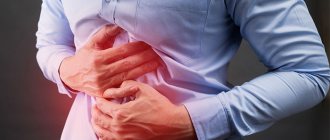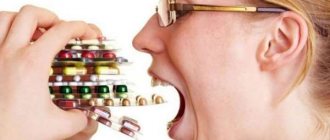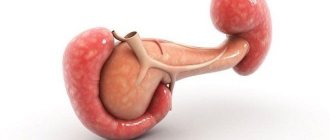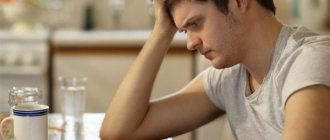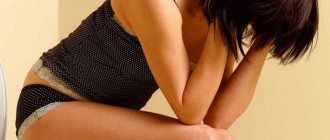First aid for pancreatitis is provided at home while the ambulance team is on the way. Help must be provided competently, since illiterate behavior can complicate the situation and can lead to death.
Inflammation of the pancreas is a fairly serious disease of the digestive system, which is mainly chronic in nature, but sometimes goes into an acute phase: the patient experiences severe abdominal pain, nausea and often incessant vomiting, and therefore measures must be taken immediately, which is why It is very important to learn how to provide first aid for pancreatitis at home.
Thanks to this, you can significantly alleviate the patient’s condition even before the medical team arrives. However, just knowing the medications needed to reduce symptoms is not enough: you need to have an idea about the disease itself and the mechanism of its development - only in this case will your actions be competent and correct.
The mechanism of pain in pancreatitis
Inflammatory and degenerative processes that occur in the pancreas are called pancreatitis.
The mechanism of pain is influenced by the following processes occurring in the pancreas:
- Blockage (obstruction) of the ductal system of the gland due to stagnation of pancreatic juice and bile in the ducts. Stagnation occurs as a result of a sharp spasm of the gland ducts, changes in consistency (increased viscosity due to alcohol abuse, poisoning of the body) of pancreatic juice or due to the appearance of tumors, stones, or the work of parasites (worms) in the ducts.
- Violation of tissue microcirculation. When pancreatitis occurs, there is a decrease in blood flow in the gland, the cells of which are poorly supplied with blood.
- Dystrophic changes in the pancreas. Tissues are corroded by pancreatic enzymes, which accumulate in greater quantities than necessary.
- Inflammatory processes that cause swelling of the tissues and supporting stroma (structures) of the gland. As a result, the pancreas becomes enlarged and swollen.
Diet food
As time passes, it is imperative to follow diet No. 5, as it will help avoid the development of prediabetes. Patients suffering from impaired functioning of the pancreas have a high risk of developing diabetes mellitus. Nutrition should be based on the consumption of:
- cheese;
- some dried bread;
- pasta;
- porridge;
- fermented milk products;
- vegetables;
- lean meat;
- sweet fruits.
The use should be avoided:
- fresh cabbage;
- legumes;
- sparkling water;
- smoked products;
- fatty meat;
- fresh baked goods;
- sour fruits;
- fatty dairy products.
Provoking factors
Experts identify many reasons for the occurrence and progression of pancreatitis. According to statistics, in 30% of patients the cause of inflammation of the pancreas cannot be determined.
Pancreatitis can be caused by:
- Drinking alcoholic beverages in excessive doses. Alcohol is one of the main causes of pancreatitis; with regular drinking of strong drinks, iron ceases to function normally, which has an extremely negative effect on the health of the entire body.
- Errors in nutrition. Fatty, fried and spicy foods, systematic overeating lead to excess production of gastric juice and damage to the gland.
- Abnormalities in the functioning of the gallbladder (cholelithiasis). The pancreas and gallbladder have a common excretory duct into the duodenum. If the duct is clogged with stones, stagnation of digestive secretions occurs, which causes inflammation or destruction of the gland.
- Stressful situations, nervous overstrain.
- Injuries, abdominal operations, wounds of the abdomen, abdominal cavity, in which the pancreatic gland may be damaged.
- Diabetes mellitus.
- Hormonal disorders.
- Infections (flu, mumps, colds, viral hepatitis).
- Neoplasms in the peritoneum.
- Hereditary predisposition.
- High blood pressure.
- Inflammatory diseases of the gastrointestinal tract and duodenum. Gastritis, duodenitis, and ulcers can negatively affect the release of intestinal juice.
- Negative effects of medications. Many medications, antibiotics, hormones, and non-steroidal anti-inflammatory drugs have a negative effect on the pancreas and can cause inflammation.
Why does an attack of pancreatitis occur?
An attack of pancreatitis occurs when the functioning of the pancreas is disrupted under conditions of increased functional activity. Under these conditions, conditions are created for the release of large amounts of digestive enzymes, which triggers the reactivation of inflammation in the organ.
The causes of exacerbation of chronic pancreatitis are:
- Poor nutrition (eating large amounts of fatty foods, overeating, eating spicy, fried, salty, smoked foods).
- Drinking alcoholic beverages.
- Smoking.
- Uncontrolled use of medications.
- Attachment of a secondary infection.
- Diseases of neighboring organs of the digestive system (liver, gall bladder, stomach).
- Pregnancy.
Important! The most common causes of attacks are errors in diet (consumption of spicy, pickled, smoked foods) and alcohol consumption.
The nature and localization of pain in pancreatitis
Painful sensations during pancreatitis can be different, have daily recurrence and depend on the anatomical location of the lesion - the area of the pancreatic lesion (head, body, tail), and the type of inflammatory process. The nature of pain with pancreatitis varies:
- cutting;
- pricking;
- aching;
- spicy;
- blunt;
- pressing;
- burning;
- drilling;
- pulling.
In chronic pancreatitis, there is no clear localization of pain; it can vary in intensity and occur periodically (cramping type). Increased pain occurs at night. With chronic inflammation of the gland, pain is localized in:
- upper and middle abdomen;
- lumbar region, in the form of a full belt or partial - on the left side; back area;
- lower chest (lower ribs area).
In acute pancreatitis, patients feel a pulling, unbearable, sharp, squeezing, acute and girdling pain, which is localized in:
- left side of the abdomen;
- back;
- left hypochondrium;
- abdominal cavity.
Cautions and contraindications
Help for an acute attack and exacerbation of a chronic process is provided in different ways. A patient with chronic pancreatitis is aware of his condition, so he can report a relapse independently.
An acute attack is characterized by severe, sudden pain in the stomach and left hypochondrium. Pain syndrome in both chronic and acute pancreatitis is accompanied by uncontrollable vomiting and fever.
Signs of acute pancreatitis: how to recognize in time
Acute pancreatitis has pronounced symptoms. The pancreas becomes inflamed and pain occurs in the area where it is located. They reach such strength that the patient can lose consciousness. However, pain in the abdominal area also occurs with other diseases, not only with pancreatitis. Help for pancreatitis can begin to be provided only after differentiating inflammation from other gastrointestinal diseases. To accurately determine whether pain is related to the gland or not, several tests are performed.
One of the simplest is the Mayo-Robson test. A line is drawn from the navel to the middle of the lower rib (on the left). Approximately in the middle of this line you should press the skin. If pain occurs, then pancreatitis should be suspected. Other signs of exacerbation of pancreatitis:
- nausea and vomiting;
- diarrhea (stools are gray, greasy, watery, with pieces of undigested food);
- loss of appetite;
- increased pain when eating, as well as when lying down.
Also, exacerbation of pancreatitis can be checked using Kert's symptom. At a height of about 5 cm from the navel, on the left side of the abdomen, tense muscles are found. This protective mechanism occurs if an internal organ is damaged, in this case the pancreas.
First aid
What to do if severe pain develops in the pancreas and how to relieve pain if an unexpected pancreatic attack occurs? Every person suffering from this disease should know the answers to these questions.
It is important to know that self-medication is highly discouraged, since illiterate actions can cause serious complications and lead to irreversible consequences.
Under standard living conditions, if acute painful sensations occur in the area of a parenchymal organ, it is necessary to immediately call qualified emergency specialists who can provide first aid and hospitalize the patient in a hospital setting, where he will be fully examined, the cause of the exacerbation will be identified and appropriate treatment will be prescribed. If necessary, emergency surgery may be required.
But a situation may also arise when the help of a qualified specialist will not be available at the right time, so you need to know how to treat pancreatitis at home and how to properly provide first aid in the event of a pancreatic attack and relieve pain.
What is not recommended to do during attacks of pancreatitis?
Emergency care for acute pancreatitis involves taking competent actions. Incorrect assistance during an attack of pancreatitis can cause an even greater aggravation of the current situation and lead to death. To prevent such situations, you need to know what is not recommended to do:
- The consumption of any food products, even fresh fruit crops, is strictly prohibited.
- It is not recommended to take enzymatic drugs in the form of Festal, Creon, or Mezim during an attack to eliminate acute pain, as they increase the level of gastric juice release, which will increase the intensity of the symptomatic manifestation of a pancreatic attack.
- First aid for pancreatitis should not consist of taking painkillers before the arrival of an ambulance team, since taking drugs such as Baralgin, Analgin, Spazmalgon will completely distort the clinical manifestations of the pathology and will interfere with accurate diagnosis and diagnosis.
People who have experienced attacks of this nature not for the first time know three basic rules of first aid for inflammation of the pancreas: hunger, cold and rest. It happens that before the ambulance arrives, antispasmodics begin to act and the attacks subside a little. Patients refuse hospitalization and thereby endanger their lives. Pancreatitis is an insidious disease; it cannot go away on its own, so if the above symptoms appear, you should not delay visiting a doctor. Treatment of pancreatitis is carried out only in the hospital; there is no question of any home procedures.
First aid for acute pancreatitis
What to do in a situation when an attack of pancreatitis has caused such a shock that you need to somehow hold out until the ambulance arrives? Moreover, if the patient is away from home, and it is problematic for emergency doctors to quickly reach him.
Emergency first aid for acute pancreatitis is to relieve pain and eliminate the reason why the clogged pancreatic ducts cannot cope with the drainage of bile juice. While waiting for the doctor you need to:
- Be completely at peace. You can lie down in bed and relax your stomach as much as possible. If the pain intensifies while lying on your back, you need to take a sitting position and bend forward. The subsiding pain in the fetal position will confirm that acute pancreatitis is occurring.
- Breathe shallowly and hold your breath to soothe the pain.
- If you have a strong urge to vomit, empty your stomach using the “two fingers in your mouth” system. There will be temporary relief.
- Apply cold to the painful area or to the projection of the pancreas from the back (a heating pad with cold water, bagged frozen vegetables, wrapped in a towel will do).
- In case of severe pain, resort to antispasmodics (duspatalin, no-shpe) or calcium antagonists (verapamil), painkillers will not work. Most often, an attack of acute pancreatitis is provoked by a large dose of alcohol and fatty foods, but medications containing pancreatic enzymes should not be taken during the symptoms of an attack - they worsen the condition.
- Refuse food completely, drink a little water (¼ glass every 30 minutes). Even if your health improves, you cannot refuse hospitalization at the clinic.
Principles of emergency care
The effective elimination of acute pain is facilitated by adopting a motionless fetal position. It is necessary to free the patient from clothing that is constricting and squeezing the abdominal cavity.
It is also recommended to increase the level of fluid consumption, namely, ensure maximum consumption of alkaline drinks in the form of mineral water without gases or a weak soda solution.
Cold in the form of a heating pad or a plastic bottle with ice should be applied to the area of the abdomen where acute pain is most intense. As the bottle with ice warms up, it is necessary to replace it with another, cooler one.
After the pain in the area of the parenchymal organ has subsided, the fetal position can be changed to a sitting position with a slight tilt of the torso forward.
The patient's breathing requires special attention. To reduce the pain threshold in the peritoneum, it is recommended to occasionally hold the respiratory act, or provide shallow breathing. Easier breathing will help create calm in the peritoneal cavity, which will reduce pain.
Among other things, to facilitate the general well-being of the patient, it is recommended to force the passage of vomit by pressing with your fingers on the root of the tongue. If this method does not help to induce vomiting, then to induce it, you can drink at least 2 liters of salted warm water, which will help not only to expel the vomit, but also to replenish the mineral balance in the patient’s body.
It is important to remember that following the above recommendations for providing emergency care during attacks of pancreatitis only contributes to temporary relief of the patient’s well-being. Therefore, you should not put off visiting a qualified specialist, but immediately undergo the necessary examination methods and begin therapeutic treatment for inflammation of the pancreas as early as possible.
Urgent care for acute pancreatitis is provided correctly and on time. It is necessary to correctly diagnose the disease and help the body cope with pain before the ambulance arrives.
Independent emergency care at home can only be provided in case of exacerbation of a chronic process. Anyone can provide first aid correctly, even without medical education. To do this, just learn the rules below.
Hunger, cold and peace
Emergency care for acute pancreatitis is based on complete abstinence from food. This requirement is explained very simply. The pancreas is corroded by digestive enzymes, which are produced in response to chewing or psychological signals (a person sees food). If you refuse to eat, enzymes will stop being produced, and the process of organ necrosis will stop.
The pancreatic area should be periodically cooled to slow down the decay process and eliminate pain. Every few hours, you can apply an ice pack to the area of the pancreas. You can hold it for no more than 15 minutes to avoid hypothermia. The patient should be protected from work and external stress, since psychophysical overload accelerates the process of necrosis.
Correct body position
To reduce the severity of pain, you should lie down or sit down and then lean forward slightly. In this position, the enzymes of the gland spread more slowly, and the pain becomes less noticeable. To fix the patient in the desired position, you can place a pillow or bolster under your back. It is necessary to remove clothes from the stomach. Constrictive materials increase the risk of complications of pancreatitis.
Anesthesia
First aid for exacerbation of chronic pancreatitis necessarily includes taking antispasmodics. These drugs are in any first aid kit. They not only relieve pain, but also cause the outflow of secretions from the organ. Before the ambulance arrives, you can use tablets or injections of Drotaverine, No-shpa. The action of the antispasmodic does not completely eliminate pain, but protects the patient from painful shock. If painkillers are not taken, this condition can be fatal.
In professional settings, if the patient is in the emergency room or in the emergency room, it is possible to use a solution of papaverine hydrochloride. This substance is given in the form of subcutaneous or intramuscular droppers. It restores the outflow of enzymes, relieves spasms, reduces pressure on the gastrointestinal tract, thereby completely relieving pain.
Correction of water balance and other body functions
Drinking water promotes the flow of bile. Any other liquids (juices, teas, coffee) cause activation of digestive enzymes, unlike water, which is completely safe for pancreatitis. It does not harm the patient’s health if consumed in fractions: a quarter of a glass. Normalization of water balance is an important element of emergency care for pancreatitis. You need to drink clean water! Drinking water can reduce the frequency of vomiting and diarrhea. By taking fluids, water balance is restored and the risk of serious damage to the pancreas is reduced.
Acute pancreatitis. Providing first aid.
The share of acute pancreatitis is 12% of all acute surgical diseases of the abdominal organs.
The development of this disease is facilitated by various factors: mechanical, nutritional, infectious, trophic, vascular, autoimmune, allergic, etc.
In the vast majority of cases, acute pancreatitis develops primarily as an independent acute disease of the pancreas. It is characterized by acute neuroreflex and vascular disorders in the pancreas, which are accompanied by a violation of its exocrine function and the development of autoimmune processes in the tissues of this organ.
pancreatic cells are damaged under the influence of various factors, trypsinogen is converted into trypsin, kallikreinogen into kallikrein, chymotrypsinogen into chymotrypsin, and carboxypeptidase is activated.
Subsequently, due to the activation of enzymes (trypsinogen, chymotrypsinogen, lipase, etc.) and the progression of vascular disorders, severe destructive changes develop, up to the complete destruction of the gland and the subsequent development of necrotic changes in the surrounding tissues and organs of the abdominal cavity and retroperitoneal space.
Of great importance in the pathogenesis of acute pancreatitis are the activation of its own enzymes, especially proteases (trypsinogen, chymotrypsinogen) and lipase, which is formed in the pancreatic ducts. Activation of trypsin and lipase can occur either sequentially or simultaneously. Trypsin primarily affects blood vessels, causing their paralysis, as well as hemostasis and massive edema with subsequent hemorrhages. Due to hemorrhages and poor circulation, cellular proteins are denatured and easily “digested” by active proteases.
The trypsin effect explains the course of the initial phases of acute pancreatitis and the development of hemorrhagic necrosis of the pancreas.
Another important pathomorphological substrate of acute pancreatitis - fat necrosis - is associated with the action of activated lipase, which breaks down tissue neutral fats into glycerol and fatty acids. Glycerol, being soluble in water, is absorbed, and fatty acids bind locally with calcium salts, forming insoluble soaps.
Thus, the leading role in the development of acute pancreatitis belongs to the activation of pancreatic enzymes and the kallikrein-kinin system, accompanied by the entry of enzymes and breakdown products of the pancreas and surrounding tissues into the blood, lymphatic system and abdominal cavity.
The most appropriate division of acute pancreatitis into interstitial (edematous form), hemorrhagic (hemorrhagic edema), necrotic (pancreatic necrosis - fatty, hemorrhagic; total, subtotal) and purulent.
The clinical picture of acute pancreatitis depends on the phase, localization and extent of pathological changes, on the degree of enzyme activation, as well as on the presence of complications.
The disease most often occurs in people over 30 years of age. Mostly women are affected.
In the clinical course of progressive acute pancreatitis, three periods are distinguished:
- hemodynamic disorders, enzymatic toxemia and ancreatogenic shock (1st - 3rd day);
- functional failure of parenchymal organs (3rd - 7th day);
- postnecrotic and purulent complications: purulent melting of the pancreas, retroperitoneal phlegmon, diffuse peritonitis and sepsis.
The main symptom of acute pancreatitis is pain in the epigastric region, often of a girdling nature. The pain is usually accompanied by vomiting, sometimes uncontrollable, painful, and not bringing relief. A common symptom of acute pancreatitis is dynamic intestinal obstruction. U
In some patients, palpation reveals moderate muscle tension in the epigastric region, in the area of the pancreas (Korte symptom), disappearance of pulsation of the abdominal aorta above the navel (Voskresensky symptom), pain in the left costovertebral angle (Mayo-Robson symptom). In the first days of the disease, body temperature rises sharply. The development of severe intoxication and microcirculatory disorders is indicated by the appearance of hemorrhagic spots on the lateral walls of the abdomen (Turner's symptom), purple spots on the skin of the face and abdomen (Mondor's symptom), cyanosis of the abdominal skin (Halsted's symptom), icteric discoloration of the skin around the navel (Cullen's symptom), pain on percussion over the pancreas (Razdolsky's symptom), hyperesthesia of the skin above the navel (Makhov's symptom). In some patients, percussion sound in the lateral canals of the abdominal cavity is dulled due to the appearance of exudate. When the distal part of the common bile duct is compressed by infiltrate in the head of the pancreas, icterus of the skin and sclera is observed.
Acute pancreatitis is characterized by the so-called plurivisceral syndrome.
The functions of the lungs, liver and kidneys are especially often impaired. In 30 - 35% of patients with acute pancreatitis, severe pulmonary complications occur - pneumonia, atelectasis, pleurisy. Shock lung syndrome develops in 20 - 25% of patients.
Most patients have impaired liver function. In severe cases, pancreatic necrosis causes acute liver failure.
Characteristic changes are also found in the cardiovascular system. In many patients (up to 25%), the disease begins with severe collapse. In later stages, hypotension and tachycardia appear. The ECG sometimes shows changes in the heart muscle, reminiscent of those during myocardial infarction. As the patient's condition improves, these changes disappear.
Some patients with acute pancreatitis experience kidney damage (focal nephritis, tubular nephrosis). In severe acute pancreatitis, acute renal failure may develop. Hypovolemia, hypocalcemia, hypokalemia and dehydration are noted. The content of chlorides and sodium decreases less frequently; this occurs with the development of paralytic intestinal obstruction.
With the development of pancreatic necrosis, the condition of patients sharply worsens, the phenomena of intoxication, severe paralytic intestinal obstruction and peritonitis increase. Painful vomiting does not bring relief and leads to dehydration. First, the vomit contains stomach contents, then mucus mixed with bile. Sometimes the vomit is the color of coffee grounds. Typically, patients complain of a feeling of bloating in the abdomen, retention of stool and gas. Due to dehydration of the body, oliguria of varying degrees is observed, in severe cases - anuria.
With purulent pancreatitis , high body temperature (38 - 39 ° C), high leukocytosis with a sharp shift in the leukocyte formula to the left are noted.
Diagnosis of acute pancreatitis at the prehospital stage is based on the study of patient complaints, anamnestic data and objective research data.
Differential diagnosis.
Acute pancreatitis should be differentiated from a perforated gastric or duodenal ulcer, acute cholecystitis, intestinal obstruction, food toxicity, renal colic and cardiovascular diseases.
Perforated ulcers of the stomach and duodenum, unlike acute pancreatitis, have a sudden onset. Characterized by a sharp “dagger” pain in the epigastric region. At the very beginning of the disease, protective tension in the muscles of the anterior abdominal wall is determined. On percussion of the abdomen, there is no hepatic dullness; there is a history of ulcers, which is not typical for acute pancreatitis.
Acute pancreatitis occurs with rapidly increasing symptoms of intoxication and repeated, non-relief vomiting, bloating and symptoms of dynamic intestinal obstruction.
Mechanical intestinal obstruction, in contrast to acute pancreatitis, is accompanied by cramping abdominal pain, vomiting mixed with intestinal contents, severe bloating and asymmetry. The symptoms of Val, Kivul, Shlange, splashing noise and others are determined, which is not typical for acute pancreatitis! An accurate diagnosis can be established only after using additional laboratory and instrumental research methods in a surgical hospital.
Acute cholecystitis, in contrast to acute pancreatitis, is characterized by the presence of pain in the right hypochondrium, radiating to the right scapula and shoulder. Symptoms of Ortner, Kera, Obraztsov, Mussi, etc. appear. Acute cholecystitis, as a rule, is not accompanied by rapidly increasing symptoms of intoxication, collapse or shock. There are no phenomena of dynamic intestinal obstruction.
Foodborne toxic infection occurs with symptoms of acute gastroenterocolitis, sometimes with severe dysfunction of the central nervous system, which is not typical for acute pancreatitis.
With food toxic infection, there is no tension in the muscles of the anterior abdominal wall, local pain in the projection of the pancreas and phenomena of dynamic intestinal obstruction.
Thrombosis of mesenteric vessels is very difficult to differentiate from acute destructive pancreatitis due to the presence of common symptoms: intoxication, cardiovascular disorders, intestinal paresis and severe pain.
With thrombosis of the mesenteric vessels, loose stools mixed with blood may occur. Vomiting is rare; the vomit is the color of coffee grounds, which is not typical for acute pancreatitis. The pain is diffuse, uniform bloating is observed, and there is no local pain in the pancreas area. Such patients have a history of diseases of the cardiovascular system: atherosclerosis, atrial fibrillation, mitral heart disease, etc.
Myocardial infarction and angina can sometimes be accompanied by severe pain in the epigastric region and be misdiagnosed as acute pancreatitis.
Myocardial infarction is not characterized by the signs characteristic of acute pancreatitis: uncontrollable vomiting, rapid increase in intoxication, muscle tension in the anterior abdominal wall, intestinal cutting.
ECG data confirming myocardial necrosis are of decisive importance.
Patients with an established diagnosis of acute pancreatitis or suspicion of it are subject to urgent hospitalization in a surgical hospital.
At the prehospital stage, it is necessary to carry out the following therapeutic measures . To relieve spasm of the sphincter of Oddi, one of the antispasmodic drugs is administered: nitroglycerin or sustak under the tongue, 2 ml of no-shpa, 2 ml of 2% solution of papaverine hydrochloride, 2 ml of 0.2% solution of platyphylline hydrotortrate, 1 ml of 0.1% solution of atropine sulfate , 2 ml of 1% diphenhydramine solution. In case of collapse, 60 mg of prednisolone is prescribed, the blood volume is replenished through crystalloid infusions; in addition, 2 ml of Lasix are administered to remove enzymes from the body, 100,000-200,000 units of Contrical, 200 ml of a 5% solution of aminocaproic acid to inhibit the enzymatic activity of the pancreas.
In a surgical hospital, a full range of additional instrumental studies is carried out, as well as intensive conservative therapy, and, if necessary, surgical treatment.
How to relieve pain during an attack of pancreatitis
It is important to reduce pain; severe pain provokes the development of necrosis. With necrosis, organ tissues become deformed and self-destruct.
Quick help for acute pancreatitis involves relieving pain. In acute forms of the disease, urgent hospitalization is indicated. Self-administering painkillers can be dangerous; in the hospital, medications are administered through an IV.
A sitting position with the body tilted forward will help to alleviate the patient's condition a little; applying ice to the area of the pancreas is allowed.
Medicines for pain relief
If a doctor is not expected to arrive soon, it is recommended to administer 5 ml of Baralgin intramuscularly to relieve pain at home. The analgesic effect of the drug lasts up to 8 hours.
Baralgin can be replaced with Papaverine solution in a dosage of 2 ml. To quickly relieve pain, you need to administer the medicine intramuscularly or subcutaneously. “Papaverine” relieves spasms of the smooth muscles of internal organs and is considered a safe remedy.
Hunger as a method of healing
Urgent care for pancreatitis is aimed at eliminating symptoms; it is often recommended to observe complete fasting for 3 days. If your appetite is restored, you can add slightly sweetened tea with sugar or honey. After 3 days, it is allowed to use some products with caution so as not to provoke a new attack of pancreatitis.
Before starting a meal, you need to take into account the fact that the patient has not eaten for 3 days, so the stomach should be prepared for the production of digestive enzymes. On the first day you are allowed to eat no more than 200 grams. liquid semolina porridge or 200 gr. potatoes boiled in their jackets.
Also, in order not to renew inflammation of the pancreas, you need to pay attention to proper food intake. That is, food needs to be chewed more thoroughly until it becomes mushy.
It is strictly forbidden to introduce fried, spicy, smoked, fatty foods into the diet, so as not to cause irritation of the digestive tract. Prepared foods should only be consumed when they are warm; care must be taken to ensure that they are neither cold nor too hot.
For a patient recovering from an attack of pancreatitis, it is necessary to prepare food once, that is, it should not be heated.
First aid for exacerbation of chronic pancreatitis
With an exacerbation of chronic pancreatitis, the patient develops the same symptoms as during an acute attack, but they are less pronounced. Pain during the first exacerbations can be quite intense, but they gradually weaken from attack to attack. At first, the pain can be cutting and paroxysmal, and then becomes dull and aching. It is localized in the same places, but can also be felt in the lower chest, upper and middle abdomen, lower back or back.
Symptoms of exacerbation of chronic pancreatitis often appear after a diet disorder, drinking alcohol, heavy smoking or stressful situations. Sometimes, they may suddenly disappear, and such a sign may indicate the development of large-scale necrosis of the pancreas.
If such symptoms appear, you should immediately call an ambulance. If the attack is not intense, then you can call a doctor at home.
First aid for exacerbation of chronic pancreatitis includes the same measures as for an acute attack. If the patient is sure that abdominal pain is caused precisely by an exacerbation of inflammation of the pancreas, then they can be supplemented by taking certain medications:
Give the patient to take painkillers: paracetamol, spasmalgon, baralgin, metamizole, dikloberl, ibuprofen. The choice and dosage of the drug depends on the instructions of the doctor who observed the patient during an acute attack.
Give the patient 2 tablets of Allochol, which promotes better outflow of bile and natural outflow of pancreatic juice from the pancreas. This drug should only be taken on the advice of a doctor and if there are no gallstones. Taking Allochol must be accompanied by taking antispasmodics (no-shpa, drotaverine, etc.).
A cold compress will help reduce pain. Cold is applied to the pancreas area for 15-20 minutes. It is advisable to use a heating pad filled with cold water.
We should not forget that during an exacerbation of chronic pancreatitis, to eliminate pain, you cannot take various alcohol tinctures, which are recommended in some folk recipes. Taking them can aggravate inflammation in the pancreatic tissues and the patient’s condition worsens.
Differences in the chronic course of the pathology
Chronic inflammatory disease of the pancreas has the same symptoms as acute one. However, the symptoms are less intense.
The disease “manifests itself” after a violation of dietary nutrition, intensive and prolonged consumption of alcohol, and severe stress. At the same time, the patient should know that a suddenly stopped attack is evidence of extensive necrosis of pancreatic tissue. Therefore, medical consultation is necessary for such patients.
Providing emergency care during an attack of chronic pathology does not differ from the acute form. However, the patient already knows about his illness, he has been examined and has certain medical prescriptions. Therefore, the patient can take analgesics that are approved by the attending physician. Taking 2 tablets of Allochol is also indicated. The drug will help bile and pancreatic juice to “leave” the pancreas.
You can take Allochol only together with medications that relieve spasms! Use of the medicine during an attack is indicated only in chronic cases of the disease and strictly as prescribed by the doctor.
After hospitalization and an objective assessment of the patient’s condition, treatment tactics are determined individually.
How to deal with vomiting due to pancreatitis
Like acute pain, vomiting and nausea become integral signs of pancreatitis. In mild cases of the disease, nausea is not recommended to be treated with medication; it goes away on its own after the patient’s condition improves.
Debilitating vomiting causes a lot of suffering. An attack of vomiting should not be restrained; on the contrary, help the body get rid of vomit by lightly pressing on the root of the tongue.
In the acute form of the disease, when vomiting aggravates the patient’s condition, drug treatment begins as quickly as possible. Antiemetics are prescribed: Domperidone, Metoclopramide, Trimebutin. To prevent dehydration of the body, it is possible to take saline solutions (Regidron). If there is blood in the vomit, the condition has deteriorated significantly, it is necessary to urgently take the patient to the doctor.
What medications are used to treat pancreatitis?
Pancreatitis is a serious pathology; the disease can only be treated by a doctor. If the severity of the disease is severe, parenteral (intravenous) nutrition is used. Acute pancreatitis is treated in a hospital setting, chronic (in some cases) at home.
The importance of complex treatment lies in the fact that a certain group of drugs affects a specific function of the diseased organ. The selection of medications depends on the form and degree of pathology, the patient’s condition, and concomitant diseases.
Antispasmodics and analgesics
Painkillers “No-shpa”, “Papaverine”, “Baralgin” are welcome and considered necessary in the home medicine cabinet. The drugs are effective and safe. They eliminate spasm of smooth muscles and reduce pain. Sometimes they take analgesics: Paracetamol, Aspirin. In some cases, to prevent the development of allergic reactions, antihistamines are used: Atropine, Platifillin, Diphenhydramine.
H2 blockers
H2 blockers (Famotidine, Ranitidine, Cimetidine) are used to suppress pancreatic secretion. Sometimes hormones are prescribed that inhibit the acid-forming function of the stomach (Somatostatin, Glucagon). The use of such drugs is justified in pancreatic shock.
Enzyme preparations
To normalize digestion and better assimilate proteins, fats and carbohydrates, enzyme substances are used, including amylase, lipase, protease. Enzyme preparations are available without a doctor's prescription; popular products are: “Creon”, “Pancreatin”, “Festal”.
If a person is allergic to pork protein, herbal preparations are used: Somilase, Pepfiz. Enzymes are prescribed by your doctor and taken after meals. The duration of treatment depends on the form and degree of development of the inflammatory process, the age of the patient, and concomitant diseases.
Antacids
Antacids are used to neutralize and reduce the production of hydrochloric acid. The most commonly used are Almagel, Phosphalugel, Gastrozol, and Controloc. The medication is taken 1 hour after meals. It is not advisable to use it together with other medications.
Antibacterial therapy
Antibacterial therapy is prescribed in combination with other drugs.
Broad-spectrum antibiotics are prescribed: Ampicillin, Gentamicin. The main purposes of prescribing antibiotics:
- Elimination of the inflammatory process in the gastrointestinal tract;
- Preventing the spread of infection in other organs;
- Reduced bacterial complications.
The drugs are prescribed by the doctor after diagnosing the disease and passing certain tests.
First aid for an attack of pancreatitis at home temporarily alleviates the patient’s condition; if signs of the disease are established, you should immediately go to the hospital.





